Año Nuevo Island White Shark Study
Methods:
The Lure as a Tool for Studying White Sharks
You may click on the images for a larger version.
All Images are Copyrighted to the PSRF,
no use without prior written permission.
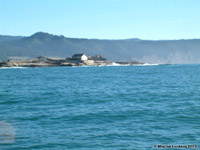
Año Nuevo Island
A white shark is a very alert and visual predator with a well known
sense of smell.
Traditionally white sharks have been lured to boats by ‘chumming’ them
up while at anchor. Chumming is a rather nebulous term but it’s basically the practice of
attracting the shark to an artificial food source and then holding that
shark’s attention there after by feeding it.
This practice started in S. Australia during the 50’ and 60’s during
the dawning of the ‘Cage Age’.
Historically everything from whale meat to horse meat was utilized by
cage diving pioneers with the staple evolving into a more restrained present
day combination of mostly tuna, shark or other mostly fish based chums
along with the odd secret recipe or ingredient added in here and there;
nothing beats a dead whale as a baiting station.
Contrary to popular belief, sharks have no aversions to the scent of
other dead sharks.
The initial attraction process used by sport divers world-wide is
almost always followed with the feeding
of the attracted animal in order to hold its attention and/or bring it
into contact with the client viewer.
This is a proven and reliable method for attracting and manipulating
white sharks by sport divers and is still the principle operating procedure
on the southern coasts of Australia and Africa and more recently near Isla Guadalupe of the
Californian coast.
More recently beginning in the early 90’s, researchers with UC Davis
and the Point Reyes Bird Observatory innovated the use of surfboards as a lure to acquire ID
images; other shapes were examined as well and researchers were able to gather
significant amount of information and understanding through this effort.
South Africa in the meanwhile has also been innovative with the use of
lures, most notably by Chris Fallows and crew; however the traditional
chumming methods are still the primary mode of attraction, especially sport-divers.
The Pelagic Shark Research Foundation began studying white sharks at
Año Nuevo Island, California in 1992.
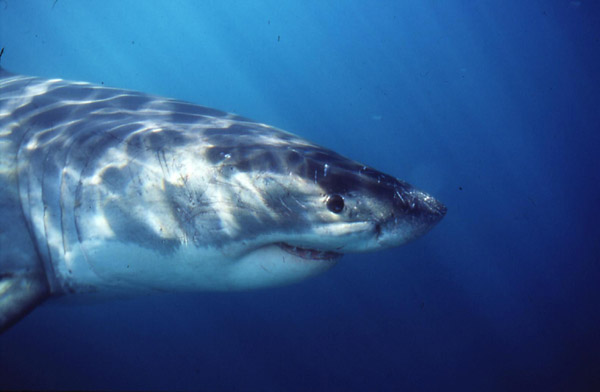 Since we weren’t interested in cage diving with these sharks or
catering to tourists, we departed from the traditional method and decided to employ
a different strategy for strictly research purposes.
Since we weren’t interested in cage diving with these sharks or
catering to tourists, we departed from the traditional method and decided to employ
a different strategy for strictly research purposes.
We developed a simple system involving a small drifting boat, a small
portion of natural bait and prey shaped lures.
Natural bait in this instance refers to a relatively fresh 15-20lb
portion of marine mammal blubber; while tuna or fish is not ‘un-natural’, it is
not what the sharks are preying upon at our particular site at Año Nuevo Island.
The marine mammal tissue is exactly what the sharks are there to feed
upon and that is what we use to attract them. We never feed them; excepting
when we fed them two baited transmitters during the 1998-99 seasons.
Rather than use a surfboard as is used at the Farallones, we went a
step further and sawed out plywood seal shapes for use as a shark lure.
Most of the shark predations we observe at Año Nuevo Island involve
large sub-adult and adult seals so we chose a shape exactly 8’ long in the shape
of a young adult female e-seal. At 95 inches long (234 cm) the lure also serves
nicely as a length measure for gathering info once a shark has made contact with
the lure.
The lure is painted brownish gray on the down-side and yellow on the
top-side; the yellow is strictly for the visual benefit of the
researchers,making it easier to keep an eye on.
The craft:
It’s a simple process that begins by going to the seal colony and
attaching the flat seal lure to a medium-heavy tackle, sportfishing- tuna rod; I
like the ‘Ugly Stick’ and Penn 6/0 and 80 lb test combo with Gamgatsu barrel
swivel and snap.
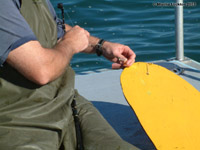 We quietly motor in near the rocky haul outs and landing areas used by
the seals and set tackle and then line up the lure for deployment.
We quietly motor in near the rocky haul outs and landing areas used by
the seals and set tackle and then line up the lure for deployment.
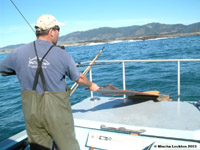 Position is everything; before we begin a drift we calculate wind,
tide and current as well paying close attention to the marine mammals and
birds whose behaviors can be discerned to indicate shark presence or
activity. During winter, 20’ foot swells are not uncommon and we often have to
work further from shore.
Position is everything; before we begin a drift we calculate wind,
tide and current as well paying close attention to the marine mammals and
birds whose behaviors can be discerned to indicate shark presence or
activity. During winter, 20’ foot swells are not uncommon and we often have to
work further from shore.
Once the lure is deployed off the stern, the boat is motored a short
distance away.
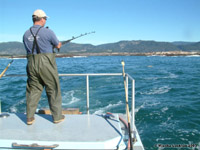
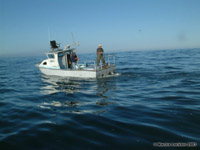 Once the lure is in position the boat is put into neutral/full-stop and
the engines turned off.
Once the lure is in position the boat is put into neutral/full-stop and
the engines turned off.
When the boat and lure are in position the bait (15 lb seal blubber) is
put into the water and the experiment begins.
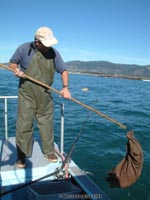 The sample itself is typically 4-6 hours per day in duration and we try
to cover every single day from October through January with periodic
visits into February.
The sample itself is typically 4-6 hours per day in duration and we try
to cover every single day from October through January with periodic
visits into February.
At the starting point of every sample drift, the time, GPS/GIS
position, water depth and temperature are recorded on a note pad. As the winter
weather kicks in the work becomes more difficult. October is typically
best and by December the there are many storms coming through that often
only allows us o go out a few day per week. We get out as often as the
weather allows, typically a season will account for 40-60 days of the Oct thru
Jan.
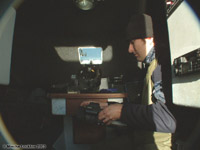 Once the conditions have been assessed and the boat/lure is positioned
and drifting; the research team prepares for contact by getting the camera
and tagging equipment ready. There are many variables to factor in as a
photographer, water clarity and ambient light being the primary
consideration. Both topside and subsurface photo/video documentation is
crucial to the study in terms of individual ID and sex categorization
as well as behaviors. Callaghan Fritz-Cope assembling an underwater housing
for digital video-camera.
Once the conditions have been assessed and the boat/lure is positioned
and drifting; the research team prepares for contact by getting the camera
and tagging equipment ready. There are many variables to factor in as a
photographer, water clarity and ambient light being the primary
consideration. Both topside and subsurface photo/video documentation is
crucial to the study in terms of individual ID and sex categorization
as well as behaviors. Callaghan Fritz-Cope assembling an underwater housing
for digital video-camera.
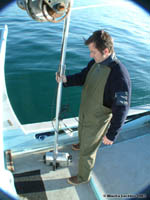 For documenting the subsurface action we utilize a housed digital vid-cam
(VX2000) mounted on a light-weight alloy boom that is both stable and
wieldy; Both top-side and subsurface actions are recorded with digital
cameras. SLR cameras are also used on a back-up basis.
For documenting the subsurface action we utilize a housed digital vid-cam
(VX2000) mounted on a light-weight alloy boom that is both stable and
wieldy; Both top-side and subsurface actions are recorded with digital
cameras. SLR cameras are also used on a back-up basis.
It can take anywhere from less than a minute to several hours to detect
the presence of a shark and they don’t always stay around for very long;
the presence can be as subtle as a point of turbulence in the water or as
obvious as a large sharks face at the lure, rarely, they will strike
the lure in a breach hit or actually bite the lure into pieces. Typically
the contact is cautious and brief.
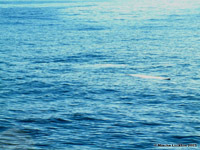 Once a shark has been detected; the alarm is raised, data noted and the
first order of priority is to get an ID image; the lure is carefully
reeled
in across the surface in hopes of interesting the shark to further
investigate, thus allowing clear ID images of the animal to be taken.
Motion on a lure will often re-motivate an otherwise reticent shark to
take interest in the lure.
Once a shark has been detected; the alarm is raised, data noted and the
first order of priority is to get an ID image; the lure is carefully
reeled
in across the surface in hopes of interesting the shark to further
investigate, thus allowing clear ID images of the animal to be taken.
Motion on a lure will often re-motivate an otherwise reticent shark to
take interest in the lure.
As well, by drawing the lure in towards the boat, the shark may be
brought within striking range of the tagging and biopsy lances. A tale tell
turbulence appears behind the moving lure.
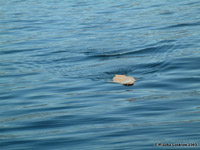
Once the lure is drawn in; the shark will often enough present itself
within reach of a tagging lance and the underwater camera.
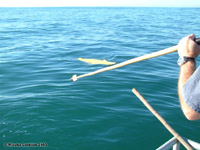
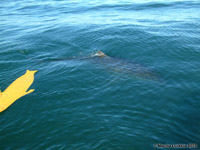
When drawn in close, the underwater camera can document the sex of each
shark encountered.
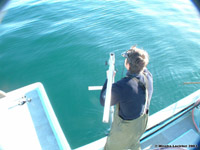
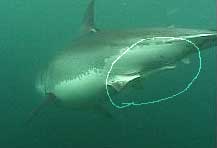
above: male shark
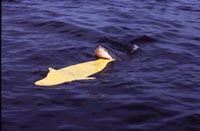



above: gravid (pregnant) female
Utilizing this system we are able to operate underwater perfectly well
without the need of a cage.
Occasionally a shark will take a brief interest in the metallic, zinc
and electro properties of the boats out-drive and stern area; the bait is
always kept from the shark’s grasp and is never directly presented to the
shark. A close watch is made on an approaching shark at all times; if a shark
appears to be intending to make contact with the boat; the handle end
of the lance is used to fend and guide the sharks from making any direct
contact with the boat. Overall the sharks are very manageable although absolute
and complete caution should be used at all times as they can be
unpredictable, explosive and volatile. In over a decade of operations at Año Nuevo
Island the PSRF has maintained a perfect safety record.
In the image below; C. Fritz-Copes tends to ‘Deca’, shark #010.
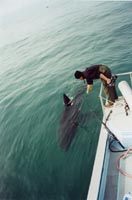 Whenever possible the sharks are carefully tagged on the dorsal saddle
with yellow ID tags, unless already tagged. In addition to the ID tags we
are periodically attaching satellite archival transmitters or “smart-tags”.
Whenever possible the sharks are carefully tagged on the dorsal saddle
with yellow ID tags, unless already tagged. In addition to the ID tags we
are periodically attaching satellite archival transmitters or “smart-tags”.
ID tagged sharks are a priority for attachment of Satellite
transmitters because the animals are already logged in to the existing data base.
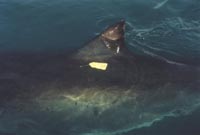 These tags record data internally and store the information until such
time that the device is programmed to automatically detach itself from the
shark and float to the surface. Once at the surface the transmitter uploads
all the stored data to orbiting satellites which in turn down-load that
information to land based computers. It makes the science easy and
unlocks mysteries that have puzzled us for long-time.
The transmitter records and later reports data on two hour intervals
(algorithms) in regards to depth, temperature and position and other
information. The satellites transmitters were designed by Paul Howie of
Microwave telemetry.
These tags record data internally and store the information until such
time that the device is programmed to automatically detach itself from the
shark and float to the surface. Once at the surface the transmitter uploads
all the stored data to orbiting satellites which in turn down-load that
information to land based computers. It makes the science easy and
unlocks mysteries that have puzzled us for long-time.
The transmitter records and later reports data on two hour intervals
(algorithms) in regards to depth, temperature and position and other
information. The satellites transmitters were designed by Paul Howie of
Microwave telemetry.

By using this system we are able to mark, count and identify individual
sharks and fit them into generational and sex categories; this allows
us to gather information on population dynamics and abundances
The lures are also interesting in regards to observing how the shark go
about handling and investigating the lures.
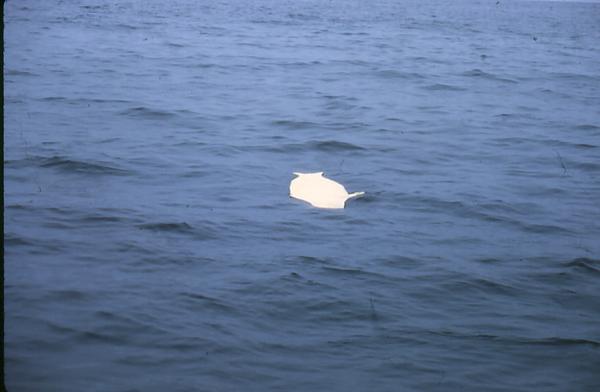
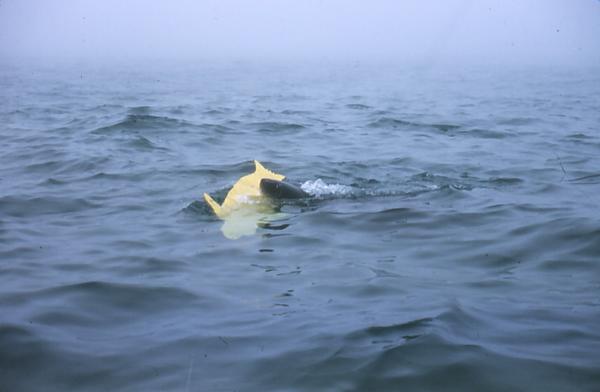
With the use of cutting edge satellite and acoustic telemetry we are
mapping out the white sharks movements and range; so far our sharks have shown
a tendency to arrive from the open ocean in Fall and patrol around the
Eastern Pacific pinniped colonies and begin to depart offshore during
December-February.
Off shore the sharks are traveling over 50 km per day and spend most of
their time at depths ranging from 300 to 700 meters deep in
surprisingly cool temps- not a lot of nocturnal/diurnal patterns are apparent to us
thus far.
We have deployed 11 acoustic transmitters and 7 satellite transmitters
thus far in addition to the ID tags.
Similar studies are being conducted at the S.E. Farallon Islands by the
PRBO researchers Scott Anderson and Peter Pyle; another team working for
Michael L. Domeier of the Pfleger Institute of Environmental Research has been
very successful in pioneering a white shark research project at Isla
Guadalupe.
Domeier’s team has placed dozens of satellite transmitters and have had
numerous re-sights of those animals while working up there.
The next few seasons should be very productive in terms of answering
many questions about the mysterious C. carcharias of the Eastern Pacific.
Always bring a pen, or something to write with:
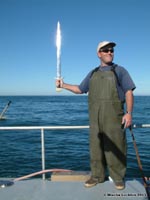
|
